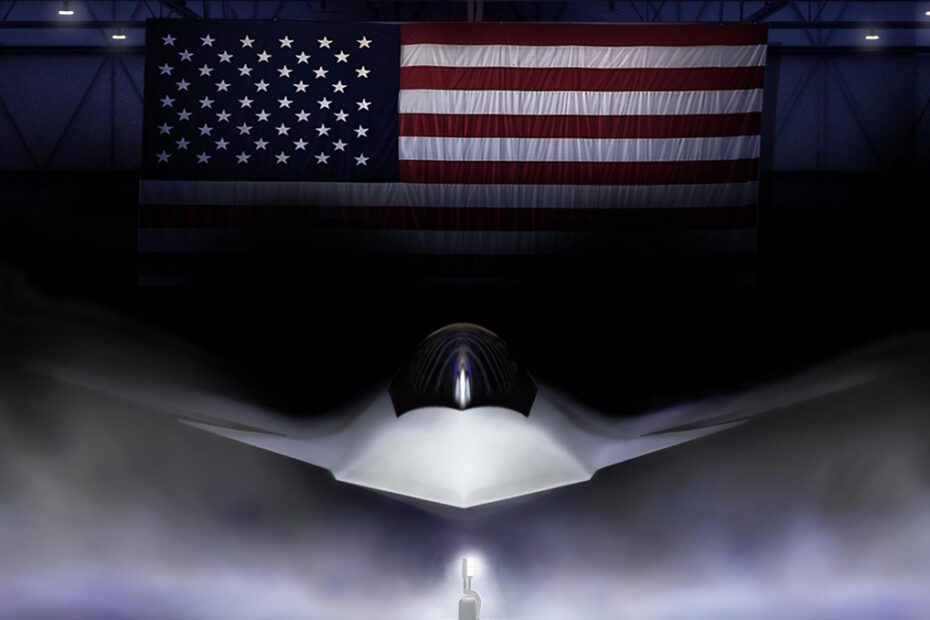Un nuovo paradigma per la superiorità aerea
Il 21 marzo 2025, il presidente degli Stati Uniti Donald Trump ha annunciato ufficialmente l’avvio del programma Boeing F-47, destinato a rivoluzionare il concetto di superiorità aerea. Il nuovo caccia, ribattezzato F-47 Thunderbolt III, rappresenta la punta di diamante del progetto Next Generation Air Dominance (NGAD), volto a mantenere il predominio aerospaziale americano nei decenni a venire.
Non si tratta di un multiruolo come l’F-16 o l’F-35, ma di un velivolo altamente specializzato progettato esclusivamente per ottenere e mantenere il dominio assoluto dei cieli. Il suo compito sarà quello di rimpiazzare gradualmente il Lockheed Martin F-22 Raptor, con una serie di caratteristiche tecnologiche avanzatissime, molte delle quali ancora coperte dal massimo riserbo.
Un raggio d’azione strategico
Uno degli aspetti più sorprendenti del nuovo caccia è il suo raggio operativo di oltre 1.600 chilometri, una distanza che va ben oltre quella dei caccia tradizionali e che si avvicina più alle performance dei bombardieri.
Questa capacità consente all’F-47 di operare in profondità in territorio ostile, riducendo drasticamente la necessità di supporto da parte degli aerei cisterna. In uno scenario come quello del Pacifico, dove le forze statunitensi si confrontano con l’espansione aeronavale cinese, questa caratteristica può rappresentare un vantaggio strategico determinante.
Inoltre, il raggio esteso permette al caccia di eludere molte delle minacce missilistiche nemiche, spingendo il Pentagono a rivedere la necessità di armamenti come il missile stealth Ngas, ritenuto ora superfluo.
Un caccia, mille droni
Un altro elemento rivoluzionario del F-47 Thunderbolt III è il concetto operativo integrato con i droni da combattimento. Il nuovo caccia sarà infatti accompagnato da una flotta di oltre 1.000 droni autonomi, denominati Collaborative Combat Aircraft (CCA).
Questi droni, in fase di sviluppo da aziende come General Atomics e Anduril, avranno il compito di affiancare il caccia in missioni ad alto rischio, fungendo da veri e propri “gregari” del pilota umano. Con un’autonomia superiore ai 1.100 km e capacità specifiche di superiorità aerea, questi velivoli senza pilota rappresentano una delle innovazioni più significative del programma NGAD.
Il concetto del “loyal wingman”, cioè il compagno fedele di squadriglia, diventa così realtà: una rete intelligente e coordinata di piattaforme autonome che agiscono come forza moltiplicatrice attorno a un nucleo ridotto ma potentissimo di caccia pilotati.
Furtività oltre ogni immaginazione
L’F-47 si distingue anche per un livello di stealth mai raggiunto prima. Classificato come “Stealth++”, il velivolo segna un’evoluzione rispetto all’“Stealth+” dell’F-22 e all’“Stealth” dell’F-35.
Sebbene non siano disponibili dati precisi sulla sua sezione radar equivalente (Radar Cross Section), è ragionevole ipotizzare che l’F-47 superi i già straordinari livelli di occultamento dei suoi predecessori. Alcune stime indicano per l’F-22 una RCS di 0,0001 m² nella proiezione frontale: l’F-47 dovrebbe essere ancora più difficile da individuare per i radar nemici.
Una scommessa industriale per Boeing
Lo sviluppo del nuovo caccia rappresenta anche una scommessa cruciale per Boeing, che ha ricevuto un contratto da 20 miliardi di dollari per la realizzazione di 200-250 esemplari.
Dopo la sconfitta subita nel programma Joint Strike Fighter – dove fu battuta dal prototipo X-35 di Lockheed Martin – la Boeing si prende una rivincita storica. Alla base del successo dell’F-47 vi sono anche tecnologie sviluppate in programmi sperimentali degli anni Novanta, come gli X-36 e Bird of Prey, concepiti dalla McDonnell Douglas prima della fusione con Boeing.
Il programma NGAD ha già prodotto dimostratori tecnologici volanti, ma i dettagli sono tuttora classificati. Il primo prototipo ufficiale dell’F-47 dovrebbe volare tra la fine del 2028 e l’inizio del 2029, cioè entro la conclusione dell’attuale mandato presidenziale.
Un nome carico di significato
Il nome Thunderbolt III non è casuale. Esso rende omaggio al leggendario P-47 Thunderbolt della Seconda Guerra Mondiale, così come all’A-10 Thunderbolt II, noto per la sua efficacia nel supporto ravvicinato.
Il numero “47”, inoltre, potrebbe anche contenere un riferimento implicito a Trump stesso, 47° presidente degli Stati Uniti. Questo dettaglio contribuisce a rafforzare la dimensione politica e simbolica del programma, che si inserisce in una più ampia strategia di rilancio della supremazia americana nel mondo.
Un progetto strategico e geopolitico
La scelta di rilanciare il programma NGAD, sospeso nel 2024 dall’amministrazione Biden per motivi economici, risponde a una visione geopolitica di lungo periodo.
Trump intende dimostrare che gli Stati Uniti non solo mantengono la leadership tecnologica, ma sono disposti a investire massicciamente per ampliarla. Il nuovo caccia diventa così anche un messaggio diretto a Cina e Russia: la corsa per la superiorità militare non è affatto chiusa, e l’America è pronta a rilanciare la posta.
Tuttavia, resta aperta la sfida più delicata: trasformare le promesse in realtà tecnica ed operativa, rispettando tempi e costi. Solo quando l’F-47 decollerà per la prima volta e dimostrerà le sue capacità, sarà possibile dire se ci troviamo di fronte a una vera rivoluzione aerospaziale o a una strategia più di immagine che di sostanza.
Conclusione: il Thunderbolt III tra mito e realtà
Per ora, il F-47 Thunderbolt III è una promessa di potenza. Una piattaforma invisibile, armata e intelligente, pensata per ridefinire il concetto di guerra aerea. Il tempo dirà se questa nuova creatura dell’industria aerospaziale americana sarà davvero all’altezza delle aspettative. Ma una cosa è certa: nel gioco delle superpotenze, la superiorità aerea è ancora oggi il fattore decisivo, e gli Stati Uniti intendono mantenerla a ogni costo.
Fonte: Wikipedia
Social Context: Il futuro del dominio dei cieli ha un nome: F-47 Thunderbolt III. Scopri il super caccia USA che volerà con mille droni al seguito. ✈️🇺🇸
Read in English

F-47 Thunderbolt III: The New Stealth++ Fighter Redefining U.S. Air Superiority
A Sixth-Generation Jet Designed for Dominance
The United States has officially unveiled the first specifications of its next-generation air superiority fighter: the Boeing F-47. Far from being a multirole aircraft like the F-35 or F-16, the F-47 is a highly specialized weapon system designed to dominate the skies. One detail stands out above all: its combat range, which exceeds 1,600 kilometers—more akin to a strategic bomber than a traditional fighter.
This extended reach, made public through an infographic by U.S. Air Force Chief of Staff General David Allvin, opens up entirely new strategic scenarios, particularly in the Pacific theater. The aircraft’s capabilities suggest a radical shift in operational doctrine, reducing the need for support aircraft and allowing deep strikes well beyond the range of adversary missile systems.
Long-Range Air Dominance
With a combat radius of over 1,000 miles (approximately 1,600 km), the F-47 is designed to conduct missions far beyond the reach of Chinese missile forces. This significantly reduces dependence on aerial refueling, keeping tanker aircraft away from high-risk zones. According to military documents, this autonomy has rendered the development of the stealth missile NGAS unnecessary.
Thanks to its range, the F-47 can now operate outside the hypothetical range of China’s most advanced weapons. This strategic advantage is one of the reasons why the Pentagon has placed such high stakes on the new fighter.
Focused Mission, Not a Multirole Platform
Unlike the versatile F-16 or F-35, the F-47 has a single mission: ensuring air superiority. It is not intended to perform multiple roles but is engineered specifically to engage and destroy enemy aircraft. In this sense, it is the spiritual successor to the F-22 Raptor, which it is expected to replace. The Raptor was also designed exclusively for air-to-air combat—a philosophy revived in the F-47 program.
The Meaning of “Stealth++”
Stealth remains a crucial component of the F-47’s design. While the F-35 is classified as “Stealth” and the F-22 as “Stealth+,” the F-47 introduces the concept of “Stealth++.” Although specific radar cross-section (RCS) values have not been disclosed, the implication is clear: the aircraft will feature even lower visibility to enemy radar.
To put things in perspective, the frontal RCS of the F-35 is believed to be around 0.005 m², while that of the F-22 can reach as low as 0.0001 m². The F-47, therefore, likely pushes the boundaries of radar invisibility even further.
Flying with a Drone Swarm
One of the F-47’s most groundbreaking features is its integration with a fleet of autonomous combat drones. The U.S. Air Force has identified two drone models under consideration: the YFQ-42A by General Atomics and the YFQ-44A by Anduril. Both offer ranges of over 1,100 kilometers and are specifically engineered for air superiority missions.
The numbers are staggering: the U.S. military plans to deploy over 1,000 of these so-called Collaborative Combat Aircraft (CCA), which will operate in concert with approximately 185 manned F-47 jets. This “loyal wingman” concept will allow a single pilot to command multiple drones in coordinated missions—an innovation that fundamentally transforms air combat strategy.
Boeing’s High-Stakes Gamble
The development of the F-47 marks a pivotal moment not just for the U.S. Air Force but also for Boeing. For the aerospace giant, this project represents a crucial bet—one that, if it failed, could have dealt a devastating blow to the company. Yet, Boeing was ultimately chosen because, as military insiders put it, “there was no alternative.”
The aircraft benefits from the technological legacy of McDonnell Douglas, acquired by Boeing in the 1990s. Experimental programs such as the X-36 and the Bird of Prey contributed essential innovations, many of which now feature in the F-47.
A Political and Strategic Statement
An official announcement of the F-47 came on March 21, 2025, from President Donald Trump, who awarded Boeing the $20 billion contract to develop the jet. The F-47 is the flagship platform of the Next Generation Air Dominance (NGAD) initiative launched by DARPA in 2014.
The jet’s numeric designation appears to honor both the 47th President of the United States and the legendary WWII Republic P-47 Thunderbolt. It may also herald the birth of the Thunderbolt III—an homage to U.S. airpower across generations.
Trump’s decision to resurrect the NGAD program—suspended by the previous Biden administration for budgetary reasons—is part of a broader geopolitical vision. His aim: to restore U.S. global dominance amid rising competition from China and Russia. In this context, the F-47 is not just a weapon but a symbol of strategic resolve.
Between Legacy and Challenge
The F-47 is also seen as Boeing’s long-awaited comeback after losing the Joint Strike Fighter competition to Lockheed Martin in 2001. That defeat saw Boeing’s X-32 lose to Lockheed’s X-35, which eventually became the F-35 Lightning II.
Now, over two decades later, Boeing has the opportunity to lead the charge into sixth-generation air combat—backed by a contract for up to 250 units and an accompanying fleet of 1,000 CCAs. This technological ecosystem may even extend to compatibility with the F-35, potentially integrating the NGAD concept with Lockheed’s still-dominant platform.
The Road Ahead: Expectations and Uncertainties
Despite its strategic importance and fanfare, the F-47 remains largely shrouded in secrecy. Official designs have yet to be revealed, and only vague silhouettes were displayed during the announcement at the White House. According to President Trump, “experimental versions of the aircraft” have been flying for five years—though no concrete evidence has surfaced.
The first flight of a full prototype is expected between late 2028 and early 2029, with operational service likely to begin around 2035. The question remains whether the program can deliver on time and within budget. If successful, the F-47 will secure American air superiority well into the 21st century. If not, it risks becoming what Chinese leader Mao Zedong once described as a “paper tiger.”
Only time will reveal whether the promises made on March 21, 2025, were prophetic or premature. For now, however, the F-47 stands as a monumental milestone in the evolution of U.S. air power.



